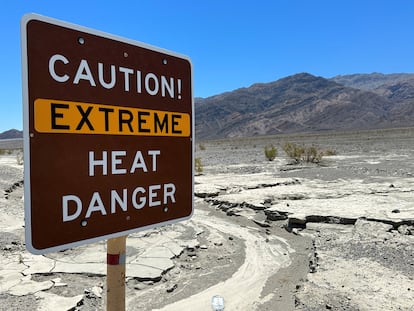Extreme heat: A chronicle of the hottest days on the planet
The impact of temperatures in the US, Asia and Europe indicating the climate moving into uncharted territory

This summer is unlike all previous ones. It started with the warmest June on the planet since records began 174 years ago, and then saw temperatures continuing to soar the following month. According to the European Union’s Copernicus Climate Change Service, the first 15 days of July have probably been the 15 warmest days on Earth since at least 1979 in terms of average daily surface air temperature.
In the past week, these rocketing temperatures have coincided with several simultaneous heat waves in the northern hemisphere with records being set in very different parts of the world. On July 16, the Sanbao weather station in the Chinese town of Turpan measured 52.2°Celsius (126°Fahrenheit), the highest temperature ever recorded in China. Meanwhile, thermometers in the U.S. reached 53.3°C (127.9°F) in Death Valley National Park in California and broke the record for the number of days above 43° (109.4°F) in Phoenix, Arizona. Extreme heat also hit Europe, where temperatures have reached 46.3°C (115.3°F) in Licata, Italy, and 45.4°C (113.7°F) in Figueres, northeast Spain. Spain’s last heatwave ended, having broken 40 new records, including the surprising record in Figueres, which became the northernmost point of the Peninsula to exceed 45°C (113°F).
This exceptional heat, which is also affecting the seas and oceans, notably the extreme warming of the North Atlantic, comes at the beginning of the onset of El Niño phenomenon, which meteorologists expect to further complicate the situation. “The onset of El Niño will greatly increase the likelihood of breaking temperature records and triggering more extreme heat in many parts of the world and in the ocean,” said the secretary-general of the World Meteorological Organization (WMO), Petteri Taalas, in May. Climatologists have been insisting all summer: climate is pushing the planet into unchartered territory.
The Intergovernmental Panel on Climate Change (IPCC) predicts that, for every 0.5°C increase in the global average temperature, there will be clearly perceptible increases in the intensity and frequency of heat extremes, including heat waves. The WMO secretary general warned that “in addition, we have to step up efforts to help society adapt to what is unfortunately becoming the new normal.”
Greece: fire and cancellations
In Athens, it is typical at the height of the summer for small businesses to close or change their hours, opening later into the evening and closing in the middle of the day. But, last week, people could only be seen on the streets in the tourist areas. At the Acropolis, free bottles of water were being handed out to tourists to help them avoid heat stroke, except on the hottest days when the archaeological sites were closed. Although 2023 is not meeting tourism expectations regarding numbers – hoteliers say they are experiencing a wave of cancellations after predicting a bumper season – millions of tourists are putting on a brave face and weathering the extreme conditions.
However, the Emergency Meteorological Bulletin, prepared by the Hellenic National Meteorological Service, warns of a succession of heat waves from mid-July until at least August. In central Greece, temperatures have exceeded 44°C (112°F), with the capital reaching 42°C (107.6°F). If these temperatures were merely peak temperatures, they would not be considered extreme; what is unusual is the number of consecutive days at which these highs are being maintained.
The most popular drink in Greece is freddo espresso, a strong frothy iced coffee. Tourists confuse it with frappé, another drink popular decades ago. Although freddo espresso is drunk year round, at this time of year the consumption soars and it is now being consumed everywhere from beaches to offices.
Forest fires is a common fallout from heat waves. On July 18, fires began to ravage forest areas in Attica, Greece. Since then, more fires have followed. On the night of July 19-20, one fire on Parnitha, one of the three mountains surrounding Athens, was near enough the capital to illuminate it with reddish light.
More than 2,000 people were evacuated on July 22 by boat from the tourist island of Rhodes due to a fire that had been raging out of control for five days. Three coast guard vessels guided more than 30 private boats from the island in the evacuation operation.

Italy: emergency phone number
The maximum temperature in Italy occurred on July 19, when temperatures reached up to 45°C (113°F) in different parts of the country. Rome hit record temperatures, bordering on 42°C (107.6°F), and up to 23 cities issued a red alert. Temperatures began to drop on July 20 in the north of the country, but in the south they continued to punish both locals and tourists alike.
The center of Rome in particular was much emptier than usual at this time of the year on July 21. Despite the fact that tourism is up about 10% over last year, the heat has forced many visitors to stay indoors until later in the day. “It’s normal: you could even say it’s dangerous to go out at this time,” explained one of the cashiers at the Colosseum at lunchtime on July 21.
The Italian Ministry of Health set up an emergency telephone number on July 19 as several people have suffered severe heat stroke. The last victim, a 63-year-old baker in Padua, died of complications due to the soaring temperatures. Animals in zoos are also under observation while the Bioparco in Rome has distributed ice cream and frozen fruit to a number of four-legged creatures help them cool off.

U.S.: more than 860 records broken
More than 90 million people in the U.S. were at risk from extreme heat on July 21, with temperatures ranging from 39.5°C (103.1°F) to 51.6°C (124.9°F). That’s just under a third of the country’s population, spread across a vast region painted dark red in the South, from Florida to Texas, and from Oklahoma to Georgia.
The epicenter is in Phoenix, Arizona, where they are beating their own record with more than 20 consecutive days above 43.3°C (109.9°F). In El Paso, Texas, they have had 35 days with highs above 37°C (98.6°F), with recent temperatures reaching 44°C (111.2°F). In Las Vegas last week, the temperature stood at 45°C (113°F) in the middle of the Nevada desert, while in Death Valley Park in California — a state where unprecedented temperatures are being recorded in the usually cooler northern region — the mercury has reached 53°C (127.4°F) in the shade and 62°C (143.6°F) in the sun, almost a world record.
Officials have been sending out extreme heat alerts every morning to remind people that between 2018 and 2020, more than 3,000 people died from heat-related causes, according to statistics from the Centers for Disease Control and Prevention. In the week that saw the third heat-related death in Death Valley, forecasters predicted that wouldn’t be the end of it. And, indeed, 85 people suffered severe burns in Arizona after contact with sidewalks reaching temperatures of up to 82 degrees. Seven died.

China: highest temperature on record
In many parts of China, the sun is also beating down with the kind of intensity that makes being outdoors a health risk. Heat waves have been sweeping across the country since June, and several regions have experienced the hottest cycles in decades. These heat cycles have come earlier and been more widely distributed and extreme than in previous years, according to meteorologists quoted by the official Xinhua news agency.
Last week, in the frying pan of Turpan, which sits snugly in China’s largest depression located in the desert region of Xinjiang, the heat was already sweltering at about 40°C (104°F) by midday. Tourists at the Jiaohe ruins shaded themselves with umbrellas and slowly made their way among the ancient houses carved into the rock of this oasis while stalls offered slices of watermelon to help mitigate the heat. On July 23, the highest temperature ever recorded in China was recorded at Turpan’s Sanbaoa weather station at 52.2°C (126°F). In the so-called Flaming Mountains, a beautiful chain of massifs that resemble flames, the Earth’s surface reached 80°C (176°F).
On July 19, the capital, Beijing, registered temperatures over 35°C (95°F) for the 28th time this year, amounting to the highest number of days with such intense heat since records began. Many locals chose to cover up with lightweight technical clothing to protect themselves from the radiation. “Normally, by now, I would have changed the stock on display,” says a saleswoman selling these garments at her stall in the Yiwu International Market, the world’s largest wholesale center. “But this year it’s so hot that I haven’t done it yet because I’m still getting customers.”

Japan: alerts and hospitalizations
More than 3,900 Japanese were hospitalized between July 3 and 9, Japanese authorities have reported. Last week, Japan issued alerts for temperatures above 35°C (95°F) in 32 of the country’s 47 prefectures or administrative regions; thermometers in Tokyo were already above 30°C (86°F) at six o’clock on the morning of July 18.
Countries across Asia have been hit by several episodes of unprecedented heat, a situation that has fueled concerns about whether they will have the capacity to adapt to extreme weather events that experts predict will become increasingly frequent.
In a recent report on the situation in the region, the World Weather Attribution, a coalition of scientists studying the impact of climate change, warns that heat waves in humid areas are far more dangerous to health and will occur 10 times more frequently in the near future. According to UN projections, there could be 30 more deaths per million inhabitants in Thailand due to heat in the next two decades, and 130 more per million by the end of the century.
A Cambridge University study warns that by 2050, heat waves in India, the world’s most densely populated country, could “push the limits of human survival.” It will affect the productivity and quality of life of between 310 and 480 million people, an “unprecedented challenge” that could seriously affect national development goals.

Contributors: Clemente Álvarez and Laura Navarro (Madrid), Hibai Arbide Aza (Athens), Daniel Verdú (Rome), Iker Seisdedos (Miami), Guillermo Abril and Inma Bonet (Peking)
Sign up for our weekly newsletter to get more English-language news coverage from EL PAÍS USA Edition

